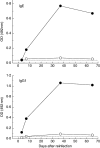The Anisakis simplex Ani s 7 major allergen as an indicator of true Anisakis infections
- PMID: 19438600
- PMCID: PMC2691976
- DOI: 10.1111/j.1365-2249.2009.03919.x
The Anisakis simplex Ani s 7 major allergen as an indicator of true Anisakis infections
Abstract
Ani s 7 is currently the most important excretory/secretory (ES) Anisakis simplex allergen, as it is the only one recognized by 100% of infected patients. The allergenicity of this molecule is due mainly to the presence of a novel CX(17-25)CX(9-22)CX(8)CX(6) tandem repeat motif not seen in any previously reported protein. In this study we used this allergen as a model to investigate how ES allergens are recognized during Anisakis infections, and the usefulness of a recombinant fragment of Ani s 7 allergen (t-Ani s 7) as a marker of true Anisakis infections. The possible antigenic relationship between native Ani s 7 (nAni s 7) from Anisakis and Pseudoterranova decipens antigens was also investigated. Our results demonstrate that nAni s 7 is secreted and recognized by the immune system of rats only when the larvae are alive (i.e. during the acute phase of infection), and that this molecule is not present in, or is antigenically different from, Pseudoterranova allergens. The t-Ani s 7 polypeptide is a useful target for differentiating immunoglobulin E antibodies induced by true Anisakis infections from those induced by other antigens that may cross-react with Anisakis allergens, including P. decipiens. The results also support the hypothesis that the Ani s 7 major allergen does not participate in maintaining the antigenic stimulus during chronic infections.
Figures




References
-
- Van Thiel PH, Kuipers FC, Roskam TH. A nematode parasitic to herring, causing acute abdominal syndromes in man. Trop Geogr Med. 1960;12:97–113. - PubMed
-
- Chai JY, Darwin Murrell K, Lymbery AJ. Fish-borne parasitic zoonoses: status and issues. Int J Parasitol. 2005;35:1233–54. - PubMed
-
- Petithory JC. New data on anisakiasis. Bull Acad Natl Med. 2007;191:53–65. - PubMed
Publication types
MeSH terms
Substances
Associated data
- Actions
LinkOut - more resources
Full Text Sources

